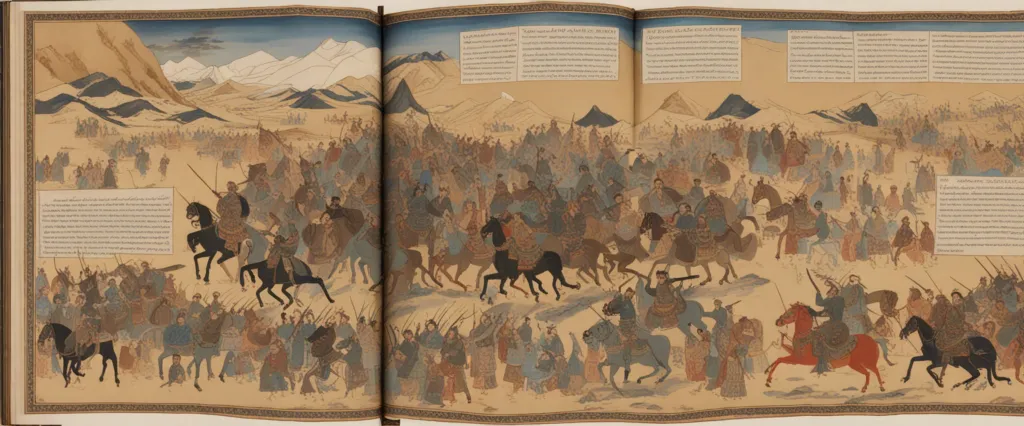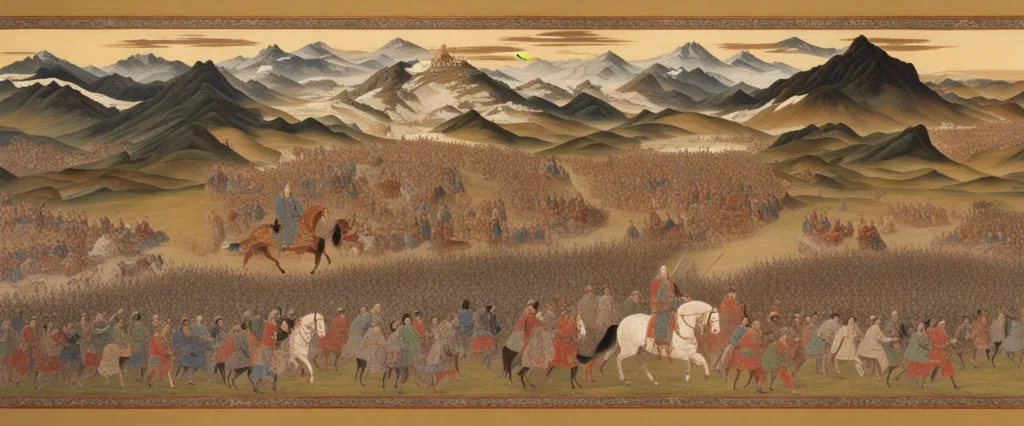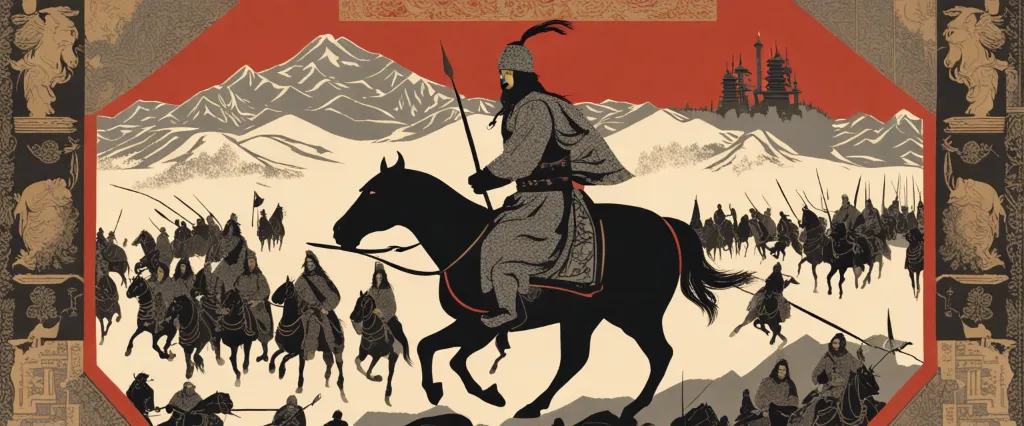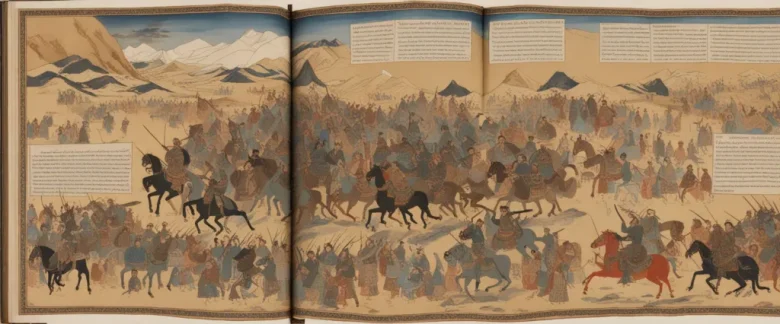
In “Genghis Khan and the Making of the Modern World,” Jack Weatherford explores the life and legacy of the infamous Mongol conqueror Genghis Khan. This captivating historical account sheds new light on the man who established the largest empire in world history, transforming the world and shaping it into what we know today. A renowned anthropologist and historian, Weatherford is celebrated for his in-depth research on Mongol culture and his unique perspective on Genghis Khan’s impact on global events. By delving into the life of this iconic figure, Weatherford uncovers the true essence of Genghis Khan’s extraordinary achievements and challenges prevailing misconceptions about his rule.
Chapter 1: The Birth of Temujin: From Exile to Conqueror
Chapter 1: The Birth of Temujin: From Exile to Conqueror, from the book Genghis Khan and the Making of the Modern World by Jack Weatherford, narrates the early life of Genghis Khan, born as Temujin, and the circumstances that led to his rise as a great conqueror.
Weatherford begins by describing the harsh Mongolian landscape of the twelfth century, where Temujin was born into a world divided by rival tribes constantly warring with each other. His father, Yesugei, was a prominent tribal leader, while his mother, Hoelun, was abducted as a young girl and later married Yesugei. However, after just a few years of Temujin’s birth, his father was poisoned by a rival clan, leaving him vulnerable in the midst of power struggles.
Weatherford emphasizes the relentless struggles faced by Temujin and his family as they were driven into exile by the Tatars, a powerful enemy tribe. Although merely a child, he had to mature quickly to survive the harsh realities of life on the Mongolian steppe. Despite their hardships, Temujin displayed remarkable leadership qualities and charisma which attracted followers, slowly building a loyal group of comrades.
Weatherford also highlights the importance of Temujin’s blood brotherhood oath with Jamuka, a fellow exile and one of his closest friends. Their bond signified loyalty, mutual support, and would prove influential throughout Temujin’s life.
Overall, Chapter 1 sets the foundation for the extraordinary life of Genghis Khan, exploring the adversities and unique circumstances that shaped him into a resilient and visionary leader. By the end of the chapter, Temujin’s tumultuous journey through exile and the bonds he formed begin to lay the groundwork for the birth of a conqueror who would go on to change the course of history.
Chapter 2: The Rise of Genghis Khan: Uniting the Mongol Tribes
Chapter 2 of “Genghis Khan and the Making of the Modern World” by Jack Weatherford delves into the rise of Genghis Khan and his success in uniting the various Mongol tribes. This pivotal chapter explores how Genghis Khan emerged from a fractured and war-torn society to become one of the most influential leaders in history.
Weatherford begins by illustrating the chaotic state of Mongol society before Genghis Khan’s rise. The Mongols were divided into numerous tribes, constantly battling and feuding among themselves. Genghis Khan, born as Temujin, faced a particularly challenging childhood, marked by poverty and the murder of his father by a rival tribe.
The chapter focuses on Genghis Khan’s early leadership skills, emphasizing his ability to unite the Mongol tribes under his influence. Genghis Khan implemented several innovative military strategies, including the non-discriminatory incorporation of talented individuals regardless of their tribal origins and the creation of a meritocratic system based on loyalty and ability rather than nepotism.
Weatherford also highlights how Genghis Khan skillfully used diplomacy and alliances to strengthen his position. He formed alliances with other Mongol leaders, establishing a united front against their common enemies. Genghis Khan took advantage of the power vacuum in Central Asia, which lacked a dominant force, and used this opportunity to expand his influence.
Furthermore, the author discusses Genghis Khan’s military prowess and intelligence gathering techniques. Employing an organized and disciplined army, he employed strategies such as psychological warfare and surprise attacks to defeat his foes. His effective use of spies, translators, and diplomats allowed him to garner invaluable information about enemy territories and cultures.
Overall, Chapter 2 illuminates Genghis Khan’s exceptional leadership skills, military genius, and strategic vision. It portrays his rise as a unifying force that transformed the Mongols from a fragmented society into a formidable empire, ultimately setting the stage for the subsequent expansion of the Mongol Empire across Asia and Europe.
Chapter 3: The Mongol Conquests: From China to Europe
In Chapter 3 of “Genghis Khan and the Making of the Modern World” by Jack Weatherford, titled “The Mongol Conquests: From China to Europe,” the author explores the expansion of the Mongol Empire, led by Genghis Khan, across vast territories from China to Europe. Weatherford highlights the innovative military tactics, political strategies, and cultural exchange that characterized the Mongols’ conquests.
The chapter begins by describing the numerous difficulties Genghis Khan faced in uniting the Mongols under his leadership. However, once he succeeded in consolidating power, he initiated a series of campaigns that would ultimately reshape Eurasia. Weatherford explains how Genghis waged war through a superior combination of horseback archery, swift cavalry attacks, and psychological warfare, which overwhelmed his enemies. He emphasizes the Mongols’ effectiveness in adopting and adapting various military technologies and techniques from their conquered territories.
The narrative then shifts to the Mongols’ expansion into China. Weatherford discusses Genghis Khan’s desire to incorporate Chinese culture and resources into his empire, forming an alliance with Chinese scholars to establish a stable administrative structure. Additionally, he highlights the role of Mongol women, who were granted significant empowerment and participation in governance, contrasting the practices of other contemporary societies.
The author also explores the Mongol conquests in the western regions, including Central Asia, Persia, and parts of Europe. During these campaigns, Genghis Khan’s sons and generals displayed exceptional military prowess and administrative skills. Through efficient communication networks and tolerance for diverse cultures and religions, the Mongols established a vast empire that fostered economic prosperity and cultural exchange.
In conclusion, Chapter 3 of the book delves into the extraordinary conquests of the Mongols from China to Europe under the leadership of Genghis Khan. It emphasizes their military innovations, political strategies, and their willingness to incorporate conquered cultures into the empire. Weatherford’s account sheds light on the profound impact of the Mongol Empire on the formation of the modern world.
Chapter 4: The Administration of the Mongol Empire: Law and Governance

Chapter 4 of “Genghis Khan and the Making of the Modern World” by Jack Weatherford focuses on the administration of the Mongol Empire, specifically examining how the Mongols established and governed their vast empire through innovative administrative systems.
The chapter begins by highlighting the Mongol legal code, known as the Yasa, which was a set of laws that unified the empire and provided guidelines for every aspect of life. The Yasa emphasized justice and fairness, offering equal protection to all citizens regardless of their social status. It also promoted religious tolerance, allowing freedom of worship for all faiths in the empire.
Weatherford then delves into the Mongols’ unique administrative structure, which was designed to maintain cohesion and control over the diverse regions of the empire. The Mongols implemented a system of four administrative divisions, or “ulus,” each led by a trusted family member. These divisions allowed for local governance while ensuring loyalty to the central authority.
Furthermore, the Mongols established a meritocratic bureaucracy, rewarding individuals based on their abilities rather than their background. This system attracted talented individuals from various regions and allowed for the appointment of officials solely on the basis of competence.
Additionally, Weatherford explores the Mongols’ efficient communication network called the “yam,” which enabled quick and secure communication across vast distances. This network facilitated trade, intelligence gathering, and the administration of the empire.
Overall, this chapter highlights the remarkable administrative systems that the Mongols developed to govern their vast empire. By emphasizing justice, implementing a decentralized but cohesive administrative structure, and fostering a meritocratic bureaucracy, the Mongols were able to effectively govern and maintain the stability and prosperity of their empire.
Chapter 5: Cultural Exchange: The Pax Mongolica
Chapter 5 of “Genghis Khan and the Making of the Modern World” by Jack Weatherford explores the cultural exchange that occurred during the Pax Mongolica. This period refers to the time when the Mongol Empire, under the leadership of Genghis Khan and his successors, established peace and stability across a vast territory stretching from China to Europe.
During the Pax Mongolica, a unique environment of mutual tolerance and communication emerged. First, the Mongols adopted and incorporated various cultural aspects from the regions they conquered. They embraced new religions, such as Islam, Buddhism, and Christianity, and actively sought out cultural knowledge from their subjects. The Mongols also encouraged trade and intellectual exchange, resulting in an unprecedented flow of ideas and inventions between the East and West.
Weatherford explains that the Mongols acted as catalysts for cross-cultural exchange, as they facilitated the transmission of goods, technologies, and philosophies. The Silk Road flourished under the Mongols, benefiting both the Mongol Empire and the nations it connected. The Mongols embraced foreign luxuries and introduced innovative practices, opening doors for multicultural experiences and interconnectedness.
One of Genghis Khan’s key contributions to cultural exchange was his establishment of the first international postal system, known as the “yam.” The yam allowed messengers to travel safely across the empire, fostering communication and the exchange of ideas over vast distances. This not only facilitated trade but also accelerated the spread of knowledge and allowed scholars to collaborate on intellectual advancements.
Overall, Chapter 5 emphasizes how the Mongols facilitated a remarkable cultural exchange during the Pax Mongolica. They promoted tolerance, trade, and intellectual pursuits, creating an environment where diverse cultures could intermingle and learn from one another. This period of cultural exchange was transformative, shaping not only the Mongol Empire but also the broader world in profound ways.
Chapter 6: Genghis Khan’s Legacy: Impact on Trade and Communication
Chapter 6 of “Genghis Khan and the Making of the Modern World” by Jack Weatherford explores the lasting impact of Genghis Khan’s empire on trade and communication. Genghis Khan’s conquests created a vast network of trade routes that spanned from Europe to Asia, known as the Silk Road, which facilitated the exchange of goods, ideas, and technologies.
One of the key contributions of Genghis Khan was his promotion and protection of trade. To ensure the safety of merchants and travelers, he enforced strict laws and severely punished those who disrupted trade routes. This policy encouraged merchants from different cultures and regions to engage in cross-cultural exchanges, leading to the spread of knowledge and innovation. Genghis Khan also founded caravanserais, rest-stops for merchants along the trade routes, which facilitated communication and the transfer of goods.
The Mongol Empire’s far-reaching communication network was another important aspect of Genghis Khan’s legacy. He established an efficient postal system, known as the Yam, which enabled secure and rapid communication across vast territories. This system used a relay of riders stationed at regular intervals, allowing messages to be delivered within days or weeks. This communication network not only facilitated trade but also enabled the Mongols to maintain control over their vast empire.
Furthermore, Genghis Khan’s empire fostered cultural and religious exchange. The Mongols were relatively tolerant of different beliefs and allowed their subjects to practice their own religions freely. This cultural diversity and religious tolerance contributed to the exchange of ideas, technologies, and art between different regions under Mongol rule.
In summary, Genghis Khan’s empire transformed trade and communication. His promotion and protection of trade along the Silk Road facilitated cross-cultural exchange and the transfer of knowledge and technologies. The establishment of an efficient postal system enabled rapid communication across the empire. Additionally, the Mongols’ cultural and religious tolerance furthered the exchange of ideas. Overall, Genghis Khan’s legacy left a lasting impact on trade, communication, and cultural exchanges between East and West.
Chapter 7: The Decline of the Mongol Empire: Succession and Fragmentation
Chapter 7: The Decline of the Mongol Empire: Succession and Fragmentation, from the book “Genghis Khan and the Making of the Modern World” by Jack Weatherford, examines the events that led to the decline of the Mongol Empire following the death of Genghis Khan in 1227.
The chapter begins by illustrating the difficulties faced by the empire after Genghis Khan’s demise. The Mongol tradition did not have a clear system of succession, leading to disputes among the ruling family, resulting in the fragmentation of the empire. Several sons and grandsons of Genghis Khan fought for power, leading to a series of internal conflicts and civil wars.
Weatherford highlights the pivotal role of Genghis Khan’s grandson, Kublai Khan, in reshaping the future of the Mongol Empire. Kublai Khan emerged as the victor and established the Yuan Dynasty in China, marking the end of the united Mongol Empire and the division of territories among different branches of the family.
The author explores the challenges faced by Kublai Khan’s successors in maintaining the empire’s vast dominion. Weak leadership, rebellions, external invasions, and cultural assimilation of conquered territories contributed to the empire’s decline. Additionally, the overstretching of resources due to continuous expansion and costly military campaigns also weakened the empire’s central authority.
Weatherford highlights the impact of regional warlords and the emerging power of local leaders in dismantling the Mongol Empire. The lack of a strong central leadership and the fragmentation of Mongol territories led to the rise of independent states, ending the Mongol dominance in Eurasia.
In conclusion, Chapter 7 focuses on the decline of the Mongol Empire due to issues of succession, internal conflicts, weak leadership, rebellions, cultural assimilation, and the fragmentation of territories. The weakened central authority paved the way for the decline and disintegration of the once mighty Mongol Empire.

Chapter 8: Genghis Khan’s Enduring Influence: Shaping the Modern World
Chapter 8 of “Genghis Khan and the Making of the Modern World” by Jack Weatherford explores the lasting influence of Genghis Khan and his empire on the modern world. The chapter highlights the impact of Mongol practices and policies on various aspects of society, including religion, trade, warfare, and governance.
One significant aspect of Genghis Khan’s influence lies in his promotion of religious tolerance. Weatherford notes that the Mongols allowed diverse religious practices within their empire and explicitly forbade the persecution of any particular faith. This unique approach paved the way for the spread of ideas, the exchange of knowledge, and the development of interconnected networks across different cultures.
The Mongol Empire also revolutionized trade, as Weatherford explains. By establishing a secure and efficient system of communication and transportation through the infamous Mongol postal system, the Silk Road flourished. This enabled the free flow of goods, technologies, and ideas across vast distances, leading to economic growth and cultural exchange between East Asia, the Middle East, and Europe.
Regarding warfare, Genghis Khan’s military innovations left an indelible mark on the modern world. The Mongol army employed organizational and tactical approaches that challenged conventional military practices of the time. The chapter notes that Genghis Khan prioritized mobility, organization, and adaptability in his forces, leading to unprecedented success on the battlefield.
Furthermore, Genghis Khan’s governance systems and policies influenced modern administrative practices. Through the use of written laws and codified protocols, the Mongols established a sense of order and stability within their empire. This system later influenced Western concepts of governance, inspiring the development of legal frameworks and bureaucratic structures.
In summary, this chapter highlights how Genghis Khan’s legacy continues to shape the modern world. The Mongol Empire’s policies of religious tolerance, trade facilitation, military innovation, and administrative organization have had a profound and enduring impact on our interconnected global society.
After Reading
In conclusion, “Genghis Khan and the Making of the Modern World” by Jack Weatherford is a captivating account that sheds light on the life and legacy of one of history’s most influential leaders. Through meticulous research and insightful analysis, Weatherford portrays Genghis Khan as a progressive and visionary ruler who consolidated the Mongol Empire and revolutionized warfare, diplomacy, and governance. The book emphasizes the significant impacts of the Mongol Empire, such as the spread of trade, cultural exchange, and the diffusion of knowledge between East and West. Furthermore, by challenging the prevailing negative perceptions of Genghis Khan, Weatherford offers a more balanced and nuanced perspective on his leadership and accomplishments. Overall, this book is an illuminating exploration of how the actions of one man shaped the course of history and laid the foundation for the modern world.
1. Decisive Moments in History Twelve Historical Miniatures” by Stefan Zweig
In this fascinating collection of essays, Stefan Zweig offers readers a unique perspective on twelve pivotal moments in history. From Napoleon’s retreat from Moscow to the assassination of Archduke Ferdinand, Zweig delves into these decisive moments with incredible insight and gripping storytelling. This book is a must-read for anyone interested in exploring the turning points that have shaped our world.
2. Lawrence in Arabia” by Scott Anderson
Scott Anderson takes readers on an enthralling journey through the life and exploits of T.E. Lawrence, the enigmatic figure who played a crucial role in the Middle East during World War I. Anderson meticulously researches Lawrence’s experiences and provides an engrossing account of his involvement in the Arab Revolt and subsequent diplomatic efforts. This book brilliantly captures the complexities and intrigue of this historical era.
3. The Shortest History of Europe” by John Hirst
For those seeking a concise yet comprehensive overview of European history, “The Shortest History of Europe” is an excellent choice. John Hirst skillfully condenses thousands of years of European history into a readable and engaging narrative. Covering key events, figures, and developments, this book is perfect for both history enthusiasts and those wanting to gain a deeper understanding of the European story.
4. “1491: New Revelations of the Americas Before Columbus” by Charles C. Mann
In “1491,” Charles C. Mann challenges conventional narratives by revealing the vibrant and complex civilizations that existed in the Americas before the arrival of Christopher Columbus. Drawing on extensive research, Mann explores the advanced cultures, trade networks, and ecological practices that shaped pre-Columbian America. This eye-opening book is a must-read for anyone interested in broadening their understanding of world history.
5. Sapiens: A Brief History of Humankind” by Yuval Noah Harari
Yuval Noah Harari takes readers on an extraordinary journey through the development of Homo sapiens in “Sapiens.” With a thought-provoking blend of science, philosophy, and anthropology, Harari explores the key milestones that led humans to dominate the planet. From the cognitive revolution to the agricultural and scientific revolutions, this book compels readers to question their understanding of history and human progress.




Comments
Your blog has the same post as another author but i like your better.